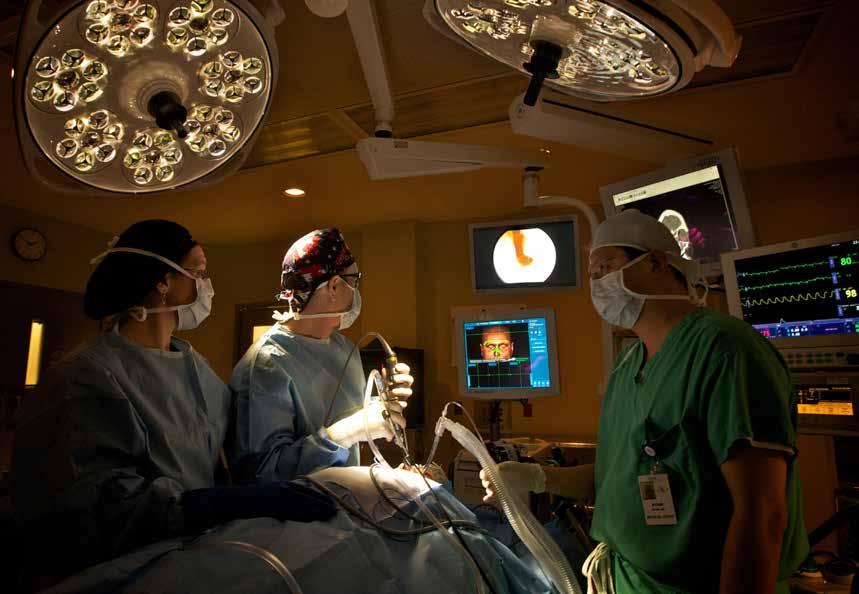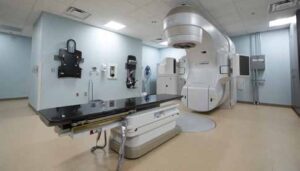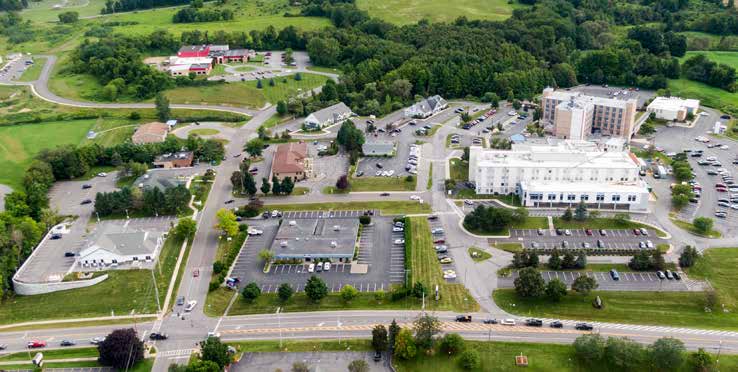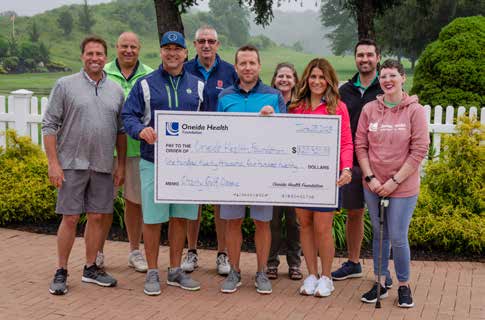By Becca Taurisano

From investments in facilities, technology, and medical staff to strategic partnerships, Oneida Heath is committed to providing the best quality outcomes and patient experience today and in the future.
THE EARLY YEARS
From the very beginning, Oneida Health’s mission has been driven by the community’s need for exceptional care, close to home. In 1894, a railroad accident in Oneida brought to light the need for immediate health care services. With a makeshift treatment room established at the Presbyterian Church to treat the railroad victims, the concept of delivering organized healthcare services in the community was born.
In 1899, Oneida Mayor, J.M. Goldstein donated a plot of land on Williams Street and Oneida Health opened the doors to its first hospital, a four-bed city-operated facility. After an expansion a few years later, it was clear more was needed and the first Broad Street Hospital was built in 1906, followed by a new 80-bed Board Street facility in 1938.
 Over the next 30 years, the Broad Street Hospital continued to expand to meet the needs of the community driving the need for a new site. In 1972, a 126-bed hospital opened its doors at 321 Genesee Street which serves as the hospital’s primary location today. Two years later, the Broad Street facility was converted into a skilled nursing facility, marking the beginning stages of Oneida Health’s healthcare system.
Over the next 30 years, the Broad Street Hospital continued to expand to meet the needs of the community driving the need for a new site. In 1972, a 126-bed hospital opened its doors at 321 Genesee Street which serves as the hospital’s primary location today. Two years later, the Broad Street facility was converted into a skilled nursing facility, marking the beginning stages of Oneida Health’s healthcare system.
“Since 1899, the growth of Oneida Health has been a reflection of the needs of our community,” says Michael Kallet, Chair, Board of Trustees of Oneida Health. “From our humble beginnings to today, our organization continues to be driven to provide convenient access to the highest quality of care possible.”
TRANSFORMATION TO AN INTEGRATED HEALTH CARE SYSTEM
With the hospital location firmly established on the hill overlooking Genesee Street and a skilled nursing facility downtown, the city-owned and operated healthcare system in Oneida continued to deliver care for the next 20 years without much change. It wasn’t until the 1990s that Oneida Health started to expand its services beyond the hospital and skilled nursing
facility.
Throughout the 1990s and 2000s, Oneida Health saw tremendous growth in services offered with the expansion of outpatient locations. This transformed Oneida Health into an integrated healthcare system.
“To best care for your community, you need to invest in providing preventative care,” says Kallet. “As an organization, we recognized this as the next step to meet the needs of our community by supporting population health and preventing more intensive and costly care
down the road.”
Recognizing the need for primary and preventive care services, Oneida Health opened its first outpatient office in Camden in 1991 marking the beginning of what is now a six-location primary care network with 18 primary care providers. To support access to diagnostic services, Oneida Health expanded its lab and imaging services with the development of five outpatient lab draw locations and two outpatient imaging centers.
In addition to the expansion of primary care, Oneida Health recognized the need for increased access to specialty services close to home. “The need for increased access to specialty services in healthcare has grown with the advancement of medicine,” says Felissa Koernig, President and CEO of Oneida Health. “Developing and nurturing a network of preventative and specialty services is instrumental to improving care in our communities.”

This commitment has created an integrated healthcare network offering specialty services that include: Allergy; Breast Surgery; Cardiology; Convenient Care; Ear, Nose, and Throat; Gastroenterology; Neurology; Obstetrics and Gynecology; Oncology; Orthopedics; Podiatry;
Pulmonology; Sleep; Vascular; and Wound Care.
A LEADER IN COMMUNITY HEALTHCARE:WORLD CLASS TECHNOLOGY
Along the way, Oneida Health has taken a strategic approach to providing convenient access to services with leading-edge technology. “As a rural healthcare organization, it is not enough to provide patients convenient access to healthcare services,” says Koernig. “Our mission is to provide patients with the best healthcare services, and to achieve this you need to pair
talented medical staff and the best technology.”
Oneida Health has had a history of investing in state-of the-art technology to support the diagnosis and treatment of its patients. In 2002, Oneida Health was the first hospital in Central New York (CNY) to introduce computeraided mammography. This was later followed by being among the first in CNY to invest in 3D mammography, the new gold standard in early breast cancer detection. With continued new investments in advanced imaging over the last decade which includes a 3-Tesla MRI and Advanced PET/CT, to name a few, Oneida Health has become a destination for imaging services.
From instituting robotic surgery in 2012 to providing TrueBeam radiotherapy, the most advanced linear accelerator and radiosurgery treatment system available,

Oneida Health ensures providers have access to the best technology when it comes to treating patients.
“It’s a common misconception that the best technology exists only in big cities,” says Kallet. “At Oneida Health, we have taken every step to ensure our talented Medical Staff has access to the best technology to treat their patients.”
STRATEGIC PARTNERSHIPS
For rural-based healthcare networks, the ability to develop highly specialized service lines can often be hindered by a lack of expertise and their ability to recruit Medical Specialists. Oneida Health has leveraged key strategic partnerships to help bridge the gap and bring
highly specialized care to Oneida.
In 2017, Oneida Health opened the William L. Griffin Medical Oncology Center followed by the Dorothy G. Griffin Radiation Oncology Center, both centers are members of the Roswell Park Care Network. The collaboration provides the Oneida region with quality cancer care that meets National Cancer Institute (NCI) guidelines, creating local access to some of the latest treatment options from a nationally ranked cancer center.
In response to an increase in diabetic patients with difficulty healing wounds, Oneida Health recently partnered with Restorix, an expert in wound care and hyperbaric medicine, to open the Wound Care Center in 2018. By developing this partnership, Oneida Health was able to bring in a high level of expertise in this specialized area to become operational in a very short time frame.
“Anytime we offer a service, we should be among the best in the area providing it, otherwise why would patients choose us,” says Koernig. “Strategic partnerships with Roswell Park, Restorix, and other healthcare systems have allowed us to leverage expertise in a collaborative effort to provide the highest quality of care on day one.”
NATIONALLY RECOGNIZED CARE
Oneida Health prides itself on exceptional care, always and has received numerous awards for high-quality care and patient experience for many years. Some of the most impressive recent highlights include:
The region’s only 5-star rated hospital by the Centers for Medicaid and Medicare (CMS) for quality care in 2021
Ranked in the top 2% of hospitals nationally for patient safety and patient experience by Healthgrades in 2019.
Women’s Choice Award for Best 100 Hospitals for Patient Experience four years in a row, 2020-2023.
A five-star recipient for Vaginal Delivery from Healthgrades for 5 years in a row (2015-2019)

“As an organization, we have a history of being committed to excellence,” says Koernig. “Awards at the national and state level are a testament to the talented Medical Staff we have at Oneida Health and their dedication to providing patients with the highest level of care at every visit.”
BUILT ON COMMUNITY SUPPORT
From a four-bed hospital to an integrated healthcare network, Oneida Health today includes a 101-bed acute care hospital, stateof-the-art robotic surgery center, 160 bed extended-care facility, multiple primary and urgent care offices, comprehensive lab and imaging services, outpatient and inpatient therapy, and a variety of specialty services providing care to approximately 29 communities with a population of over a 100,000 throughout Madison and Oneida counties.
The incredible growth and success the organization has seen over the last 125 years would not be possible without significant community support throughout its history.
Recent donations have helped support technology, expansions, and renovations of facilities like the William L. Griffin Medical Oncology Center, the Alice M. Gorman Imaging Center, the Dorothy G. Griffin Radiation Oncology Center, and the expansion of the Emergency Department and Operating Rooms including the Chapman Foundation main hospital entrance.

“So much of what we’ve achieved has been made possible
by our generous donors,” says Kallet. “From the original land donation by the mayor to our most recent donations by the Griffin Foundation for the expansion of oncology, these contributions to our mission have elevated our network to what it is today.”
Support from community groups has been essential as well, from the Oneida Health Foundation to individual volunteers and groups like the Oneida Health Auxiliary. Their combined efforts have provided valuable resources to Oneida Health’s success.
“Community-based organizations have provided their support throughout our 125 years because they believe in our vision,” says Koernig “From a single volunteer fulfilling hours of service to large financial gifts from area nonprofits, these generous acts have helped make our patient care exceptional. I extend our thanks to everyone in the community who has contributed so selflessly
over our organization’s history.”
THE NEXT 125 YEARS
As the future of healthcare changes, Oneida Health plans to stay agile to adapt to the ever-changing healthcare landscape.
“As an organization, we need to continue to look for opportunities to deliver care where it is needed and how patients want to receive it,” says Koernig. “Our ability to connect patients digitally with their providers and patient information is going to become more
essential as we move forward.”
While the method of delivering care may be changing, Oneida Health’s approach to patient care looks to remain consistent. “Our commitment to providing the highest quality of care and patient experience will continue to set us apart and remain an important reason why patients will choose us for years to come,” says Koernig.

The future of Oneida Health will continue to rest on its most important asset: its people. “As a healthcare organization, we will need to continue to recruit the highest level of talent while providing an environment where healthcare providers and professionals can thrive.

Investing in our people will ensure we’re providing care for the next century and beyond,” adds Koernig.





